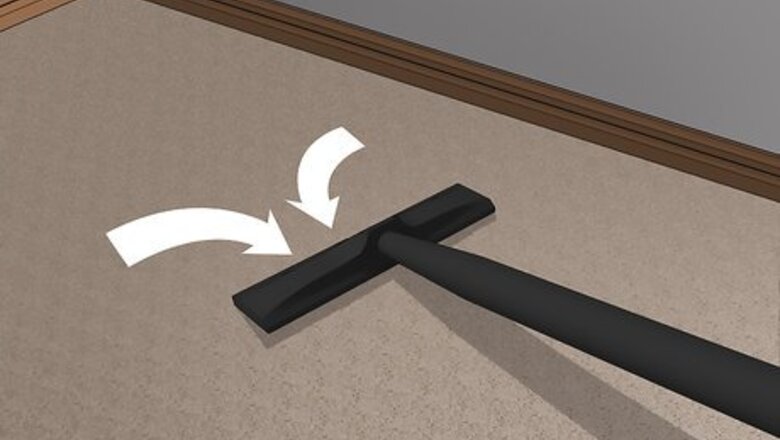
views
- Vacuum or steam clean your floors, upholstery, and bedding regularly and wash all your laundry in hot water during an infestation.
- Bathe your pets weekly and groom them daily with a flea comb. Try spraying them with a homemade citrus solution to repel fleas.
- Spread beneficial nematodes in your yard in early spring and sprinkle diatomaceous earth every 7-10 days to keep outdoor fleas at bay.
Cleaning Your Home
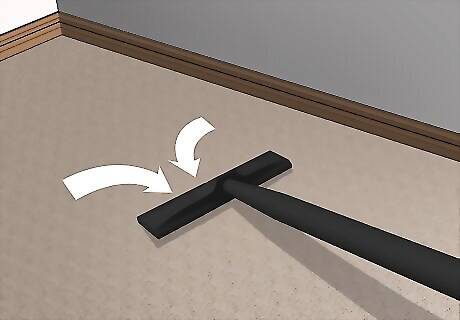
Vacuum your floors, upholstered furniture, and bedding daily. Pay special attention to areas your pet frequents, spots that don't get much sunlight, and anywhere that you've observed fleas, dried blood, or flea feces. When you vacuum furniture, remove the cushions so you can hit all the nooks and crannies. Be sure to vacuum beneath furniture, behind doors, along baseboards, and in other tight spots. During an infestation, vacuum your home daily. If you haven't seen any fleas in your home, you should still vacuum thoroughly at least once a week. When the vacuum bag is full, seal its contents in a plastic trash bag, then throw it out in a covered outdoor garbage bin.
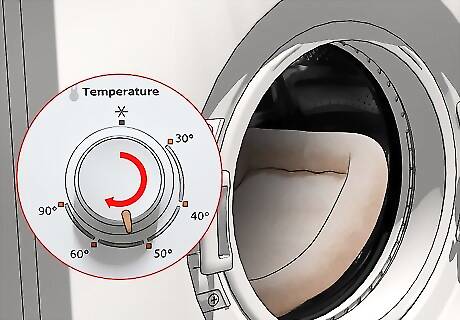
Wash throw rugs, bed linens, and your pet's bedding in hot water. Machine wash and dry sheets, blankets, pillowcases, pet beds, and small rugs weekly during an infestation. Use the hottest water and dryer temperatures that each fabric can handle. If your pet's bed isn't washable, stay on the safe side and discard it.

Steam clean your carpets and upholstered furniture. If you don't own a steam cleaner, you can rent one from a home improvement store or hire a professional. Be sure to test your cleaning solution on discrete areas of your carpets and furniture. Steam cleaning kills adult fleas and larvae, but some eggs will survive. It can take as long as 3 to 4 months for eggs to hatch, so continue to vacuum daily. Consider steaming your home every 1 to 2 months until you've brought the infestation to an end.

Try using dehumidifiers to control moisture levels. Flea eggs need humidity levels of at least 50% in order to develop and hatch. You could use a humidity monitor and dehumidifiers to make your home less hospitable for fleas. Keep in mind you'll still need to vacuum, wash bedding, and take other steps to control an infestation. The number of dehumidifiers you'll need depends on your home's size and layout. A medium-sized dehumidifier removes 40 US pints (19 L) of water from the air in 24 hours. This size is recommended for areas up to 1,500 square feet (140 m).

Use flea traps to monitor your progress. Flea traps are composed of strips of sticky paper or bowls of water that sit under a light bulb. Heat from the light attracts fleas, which get stuck on the paper or in the water. As you take steps to manage the infestation, you should start to catch gradually fewer fleas in your traps. If 1 to 2 months pass and the number of fleas in your trap remains the same, it's time to call a professional. Flea traps are a good way to keep tabs on the infestation's severity, but they only catch adult fleas. They won't eliminate an infestation on their own.

Treat your home, pet, and yard at the same time. The only way to manage a flea problem is to combat it on multiple fronts. If you clean your home without treating your pet, your home will just get reinfested. Be patient; it may take 3 or 4 months to get a flea infestation under control.
Grooming Your Pets

Bathe your pet at least once a week. Use a shampoo labeled for cats or dogs; never use shampoo for people on your pets. Begin washing your pet's head and neck first so the fleas don't jump up into its eyes, mouth, and ears. Bathing your pet any more than once a week could lead to skin irritation. Using moisturizing shampoo that contains oatmeal can help prevent your pet's skin from getting too dry.
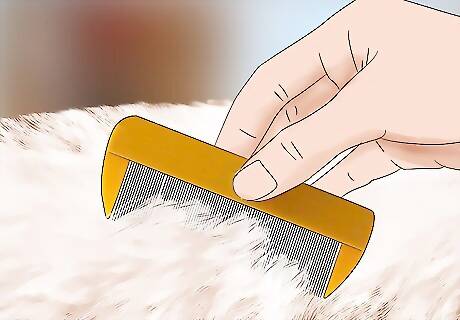
Groom your pet daily with a flea comb. At least once a day, run a fine-toothed flea comb through your pet's dry fur. Periodically dip the comb in a cup of hot, soapy water or a 1-to-1 mixture of alcohol and water to kill the fleas you pick from the fur. Watch out for fleas that jump off of your pet. While your pet's coat should be dry, a bathtub is a good place to groom it. You'll have an easier time seeing fleas against the smooth, white surface.
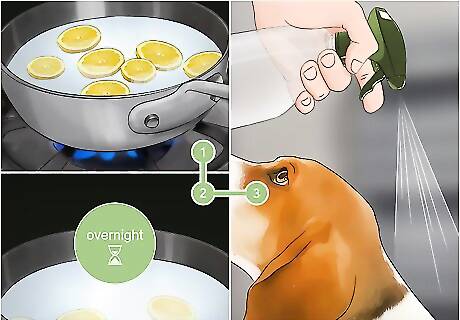
Try spraying your pet with a citrus solution. Slice a lemon thinly, and add it to pot filled with 1 US pint (470 mL) of water. Bring it just to a boil, then remove it from heat, cover it, and let it sit overnight. Strain the liquid into a spray bottle, then spritz your pet and massage the solution into its fur. You could also purchase a citrus pet spray online or at a pet store. Citrus can deter fleas for up to 24 hours, but daily applications could irritate your pet's skin. Try spraying every 3 or 4 days, and gradually spray more frequently if there are no signs of skin irritation. Avoid spraying near your pet's face. Discontinue use if you notice red or dry skin, or if your pet scratches itself persistently. It's always best to consult your pet's vet before treating it with a home remedy.
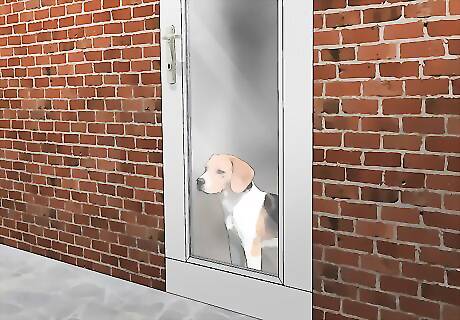
Keep your pet indoors as much as possible. If you have a cat, it's best to keep it indoors at all times. If you have a dog, take it outside for short potty breaks. When you take it out, avoid shady, damp areas with lots of overgrowth. Limiting the time your pet spends outdoors will help reduce its exposure to fleas.
Combatting Fleas Outdoors
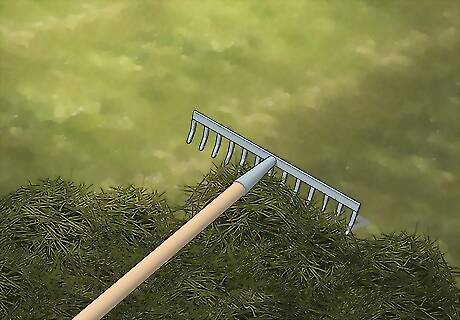
Keep your lawn short and rake up leaves. Keep any outdoor areas where your pet might hang out clean. Trim lawns and weeds to expose cool, damp dark spots to sunlight. After mowing, remove grass trimmings, and rake up any leaves or other debris that collect in your yard. Fleas thrive in shady, moist areas. Keeping your lawn short, raking, and removing debris can make your yard a less hospitable environment for them.

Spread beneficial nematodes in your yard in early spring. Beneficial nematodes are tiny worms that eat flea larvae. You can find them at a home improvement store or garden center. Look for a product labeled for flea control, and apply it to your lawn and garden beds as directed. Pay special attention to areas where your pet frequents. The best time to apply nematodes is at the start of flea season, or early spring. Typically, you mix a package that contains millions of microscopic nematodes with water, then disperse the mixture with a hose sprayer or watering can. Throughout the spring and summer, you'll need to water the soil whenever it starts to become dry. Don't worry about nematodes making you sick! Nematodes don't harm people or pets.

Sprinkle diatomaceous earth every 7 to 10 days. Find diatomaceous earth labeled for yard use at your local home improvement or garden supply store. Spread it in your yard, and concentrate on shaded spots and areas where your pet hangs out. The best time to apply diatomaceous earth is in the morning. Avoid spreading it on a windy or rainy day, and don't sprinkle it around your pets. Inhaling it can irritate the respiratory system. Diatomaceous earth is a mineral powder that scratches and dehydrates fleas. It'll lose its effectiveness over time, so you'll need to reapply it weekly, after a rainy or windy day, and after watering your lawn.

Try growing pennyroyal in your garden or in pots. Pennyroyal is a member of the mint family that's been used as an insect repellent for centuries. Grow it in your garden to deter fleas outside, or keep potted pennyroyal in your home. It's toxic to cats and dogs, so make sure your pet doesn't try to eat it. Pennyroyal essential oil is sometimes used as a flea repellent, but it's not safe for pets. Don't apply essential oils to your pet's skin, its food, or its bedding. If you grow pennyroyal in your garden, pinch shoots regularly to ensure it doesn't take over your planting area. Like other members of the mint family, it spreads aggressively. Containing the root system in a pot, then planting the pot in your soil bed can help control its growth.
















Comments
0 comment